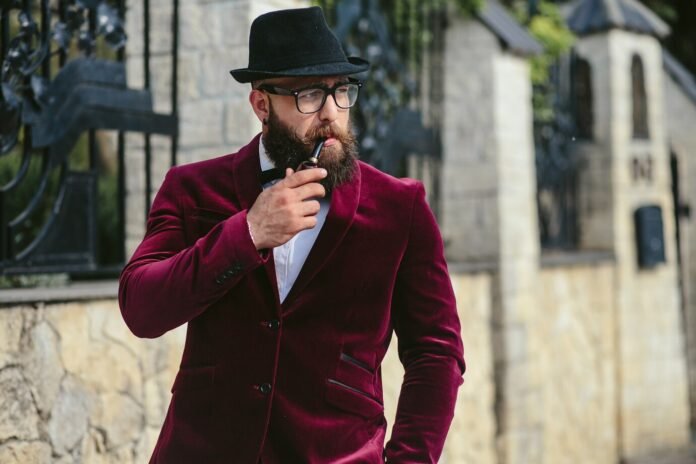The 1920s was a revolutionary decade for men’s fashion, marked by a shift from the rigid, formal styles of the Edwardian era to more relaxed and expressive clothing. This period, often referred to as the “Roaring Twenties,” saw the rise of jazz, the influence of Hollywood, and a newfound emphasis on individuality. 1920s Mens fashion became more casual yet sophisticated, with sharp tailoring, bold patterns, and innovative fabrics defining the era. From the iconic three-piece suits to sporty knickerbockers, 1920s menswear blended elegance with a sense of rebellion, setting the foundation for modern men’s style.
1. The Rise of the Lounge Suit
The lounge suit emerged as the quintessential men’s outfit of the 1920s, replacing the stiff morning coats and frock coats of previous decades. These suits were designed for comfort and versatility, featuring a single-breasted jacket with a slightly tapered waist, wide lapels, and straight-cut trousers. Fabrics like tweed, flannel, and lightweight wool were popular, often in shades of gray, brown, or navy. The lounge suit was worn for both business and leisure, making it a staple in every well-dressed man’s wardrobe.
2. The Three-Piece Suit: A Symbol of Sophistication
No 1920s gentleman’s wardrobe was complete without a three-piece suit, consisting of a matching jacket, vest (waistcoat), and trousers. The vest added an extra layer of refinement, often featuring intricate patterns or contrasting fabrics. High-waisted trousers with suspenders (braces) were the norm, creating a streamlined silhouette. This ensemble was accessorized with pocket watches, tie pins, and polished leather shoes, embodying the era’s emphasis on meticulous grooming and elegance.
3. The Influence of Jazz and the “Zoot Suit”
The Jazz Age brought a wave of bold, flamboyant styles, particularly among young men and African American communities. The zoot suit, though more prominent in the 1930s and 40s, had its roots in the late 1920s, characterized by oversized jackets with wide lapels and high-waisted, wide-legged trousers. This exaggerated style reflected the rebellious spirit of the decade, challenging traditional norms and embracing a more theatrical approach to fashion.
4. Casual Wear: Knickerbockers and Sportswear
As leisure activities like golf, tennis, and motoring grew in popularity, men’s fashion adapted with more relaxed attire. Knickerbockers—short, baggy trousers fastened at the knee—became a fashionable choice for sporting events and casual outings. Paired with argyle socks, loafers, and V-neck sweaters, this look embodied the decade’s move toward practicality without sacrificing style.
5. Accessories: The Finishing Touches
Accessories played a crucial role in completing a 1920s gentleman’s outfit. Fedora and bowler hats were essential for a polished look, while silk ties and bow ties added a touch of sophistication. Leather gloves, walking sticks, and two-tone Oxford shoes (known as “spectator shoes”) were also popular. The decade’s love for detail extended to cufflinks, tie clips, and even cigarette cases, showcasing a man’s attention to refinement.
6. Hollywood’s Impact on Men’s Fashion
The rise of cinema in the 1920s turned movie stars into style icons. Leading men like Rudolph Valentino and Douglas Fairbanks popularized sleek tuxedos, tailored overcoats, and slicked-back hair. Their on-screen elegance influenced everyday fashion, with men emulating their polished looks. The tuxedo, once reserved for formal events, became more mainstream, thanks to Hollywood’s glamorization of evening wear.
7. The Legacy of 1920s Men’s Fashion
The 1920s laid the groundwork for modern menswear, introducing concepts like casual elegance, bold patterns, and fitted silhouettes. Many elements of 1920s mens fashion—such as the three-piece suit, fedora hats, and two-tone shoes—remain timeless classics today. The decade’s blend of sophistication and rebellion continues to inspire contemporary designers, proving that the Roaring Twenties was truly a golden age for men’s style.
Conclusion
The 1920s mens fashion was a transformative era for men’s fashion, breaking away from tradition and embracing a new sense of freedom and individuality. From the sharp tailoring of lounge suits to the daring flair of jazz-inspired outfits, this decade redefined masculinity in clothing. Whether for formal occasions or casual outings, 1920s menswear combined elegance with innovation, leaving a lasting legacy that still influences fashion today.


